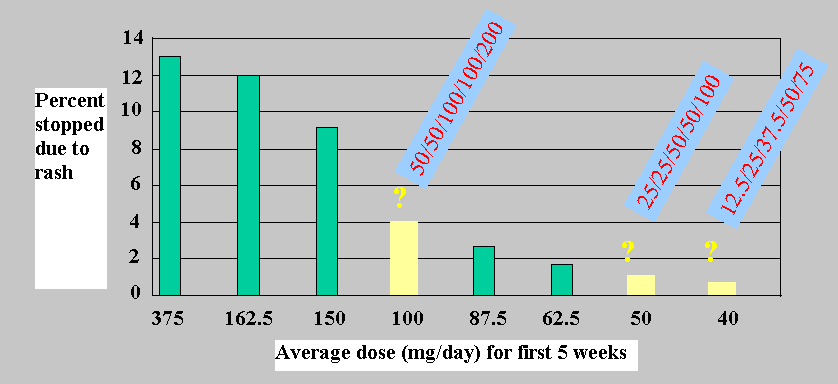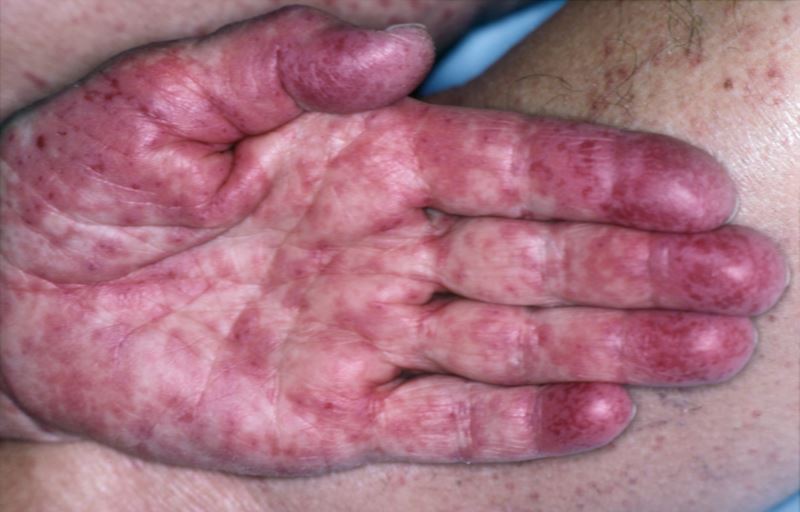First, do we know how this medication compares with others which are also recognized to cause “Stevens-Johnson Syndrome”, and other severe skin reactions? A direct comparison was attempted using a German database.Mockenhaupt The authors are current or former employees of GSK, the company that makes lamotrigine, so these numbers are still somewhat suspect until some other source repeats this kind of analysis. However, it looks to me on reviewing the design of the study that a very earnest attempt was made to capture “real” rates, not those favorable to GSK. For example, they made a series of assumptions about use rates then checked their numbers when different assumptions were made. As you can see in the following table, the results were pretty similar either way (the right-hand column shows the rate adjusted with a different assumption about the rates of new prescription):
| Generic name | (U.S. Trade Name) | Rate in 10,000 new users | Rate in 10,000 new users (adjusted) |
| lamotrigine | (Lamictal) | 2.5 | 3.8 |
| carbamazepine | (Tegretol, Equetro) | 1.4 | 1.5 |
| valproate | (Depakote) | 0.4 | 0.5 |
| phenytoin | (Dilantin) | 8.3 | 6.9 |
“Bottom line”: the rate of serious rash in this analysis is between 2 and 4 cases per 10,000 new users of lamotrigine (the manufacturer’s usual quoted rate is higher: 1 per 1,000). The rate in several other commonly used antiseizure medications is somewhat lower, except for Dilantin.
What are the signs of the bad rash?
There are ways to identify the rashes that carry great risk (e.g. Stevens-Johnson syndrome, SJS; and toxic epidermal necrolysis, TEN. Sounds scary just naming it. But that’s all right, because this is indeed a very scary skin condition). The problem is that simple rashes, lacking the known danger signs, can also be risky, so it’s not easy to say “oh, this rash is safe”. And since there is a very low rate of severe skin reactions that can (rarely) even be fatal, any rash that appears while a person is taking lamotrigine should raise concern.
What are the signs of great risk? Here are the versions I’ve heard so far:
- “Anything above the neck”
- “Around or in the mouth”
- “Soft tissues (like mucous membranes of mouth, nose, eyes — including the membrane over the eye (conjunctiva), so a red, sore eye counts) (or the anus, also a mucous membrane, also counts)
- “Anything on the face”
Obviously these all describe nearly the same areas, but the “soft tissues” version is the most specific.
Three strategies for rash
- Stop for any rash anywhere.
- Have a dermatologist see the patient within 24-48 hours; hold the doses until seen.
- Stop for any rash above the neck; for anything else, reduce the dose to the previous level, and hold it there until you can tell whether the rash is going away (if so, continue upward again but more slowly and/or by smaller steps; use Benadryl or topical Caladryl to control itching while you’re waiting).
Why the hurry to see the dermatologist? Well, the obvious reason is because if there is a risk, you want to stop right away. Secondly, if the medication is stopped for more than 3 days (for any reason; some sources say four days, a few say 5), the patient must start again from the very beginning of the dose steps. Therefore if the patient can be evaluated very quickly, she can stop the medication, get a “green light” from the dermatologist, and resume the medication at the same dose.
If you don’t have a dermatologist handy, then strategy #2 may not be practical. That leaves #1 and #3. Number 3 has been recommended in several meetings I’ve attended, e.g. by Dr. Lauren Marangell at the Menninger Utah meeting, Winter 2002. She spoke confidently of that approach there, and I’ve used it repeatedly since (now to 2014 without a problem, roughly 50 such occasions in that time). There is at least one article which notes having used this approach successfully.e.g.Huang
Rechallenge after a rash
| No recurrence of rash | In those who had rash again… | Starting dose | |
| P-Codrea et al | 16 of 19 (84%)(Followed for an average of 4 years) | Medication stopped in 3 patients. Dr. P-Codrea (personal communication) reports none had complications. | Starting dose 5 mg daily for 2 weeks; in riskier cases, 5 mg every other day |
| Tavernor et al | 6 of 8 (75%) | 1 of the 2 was “mild”; the other required dose decrease, then later was able to proceed without rash | (not reported) |
| Besag et al | 7 of 7 children (100%)(None had severe rash) | N/A | 0.1 mg |
But there’s newer review of this issue and more cases. This paper by my coauthor (Chris Aiken) shows that even some people who have had dangerous-looking rashes have been re-tried on lamotrigine and done well: getting to the full dose, eventually, with no repeat of the rash or skin problem. Here is that reference article. Read it carefully: it’s more than just a case report. (full text online)
In fact, the authors use a system for ranking the severity of a previous skin reaction, then describe how people have been restarted even when their reaction was among the most severe.
In general, the re-try approach that has been used, by several different authors, is 2.5 mg steps per week. I know, it will take a long time to get to 50 mg that way (they go faster later). Twenty weeks, to be precise: about 5 months. But if you did well on it before the skin problem hit; or if you’ve tried all sorts of other things and are prepared to take a potential risk, then at least you’d want to know that other people have re-tried lamotrigine successfully, wouldn’t you?
Never go faster than 25 mg in the first two weeks
Here’s one more bit of information which strikes me as overwhelmingly important on this question. If starting at 25 mg lowers the risk of rash, compared to starting at 50 mg — and that’s clearly been shown — , then is the risk lower yet if you start at 12.5mg? The graph below shows another way of looking at this same issue (blue bars show dose per day, by week; yellow bars are guesses, extrapolated from existing data, shown in green):
 Think about it: this medication has extremely few side effects, and does not cause weight gain (unlike all 3 main alternatives: lithium; Depakote/valproate; Zyprexa/Seroquel/aripiprazole). It also has antidepressant effects like lithium. So, this can be a great medication for someone. Why risk “blowing it” by going up a little faster on the dose and thereby raising the risk of getting the rash, and having to consider stopping entirely at that point? For most patients considering lamotrigine, they’ve had symptoms for years. Waiting another few weeks because of using a slow dose increase — and thus buying a little more insurance that they might be able to benefit and stay on this medication — just makes more sense to me.
Think about it: this medication has extremely few side effects, and does not cause weight gain (unlike all 3 main alternatives: lithium; Depakote/valproate; Zyprexa/Seroquel/aripiprazole). It also has antidepressant effects like lithium. So, this can be a great medication for someone. Why risk “blowing it” by going up a little faster on the dose and thereby raising the risk of getting the rash, and having to consider stopping entirely at that point? For most patients considering lamotrigine, they’ve had symptoms for years. Waiting another few weeks because of using a slow dose increase — and thus buying a little more insurance that they might be able to benefit and stay on this medication — just makes more sense to me.
Thus my main strategy on “handling the rash” is to try to avoid it in the first place.
Dermatologic Precautions (didn’t make a difference, but…)
[Update 5/2005: Stanford’s Bipolar Clinic, led by Dr. Terry Ketter, published their results from a strategy in which they warned patients not to add any new allergens: no new soaps, detergents, cosmetics, shaving creams, deodorants, etc; no new foods; and avoiding sunburn or poison oak. They also waited to start if the patient had recently had a rash, symptoms of a viral infection, or a rash. Using this strategy, they lowered the benign rash rate — there were no serious rashes in this group of 100 patients — to 3%, versus the common 10% rate for rash in other lamotrigine research studies.Ketter][Update 2008: when they repeated that strategy with the pharmacist giving the skin instructions, the difference in rash rates was not significant.Ketter (b) Ketter says he still gives the same instructions, despite those data.]
(revised 11/2020)
